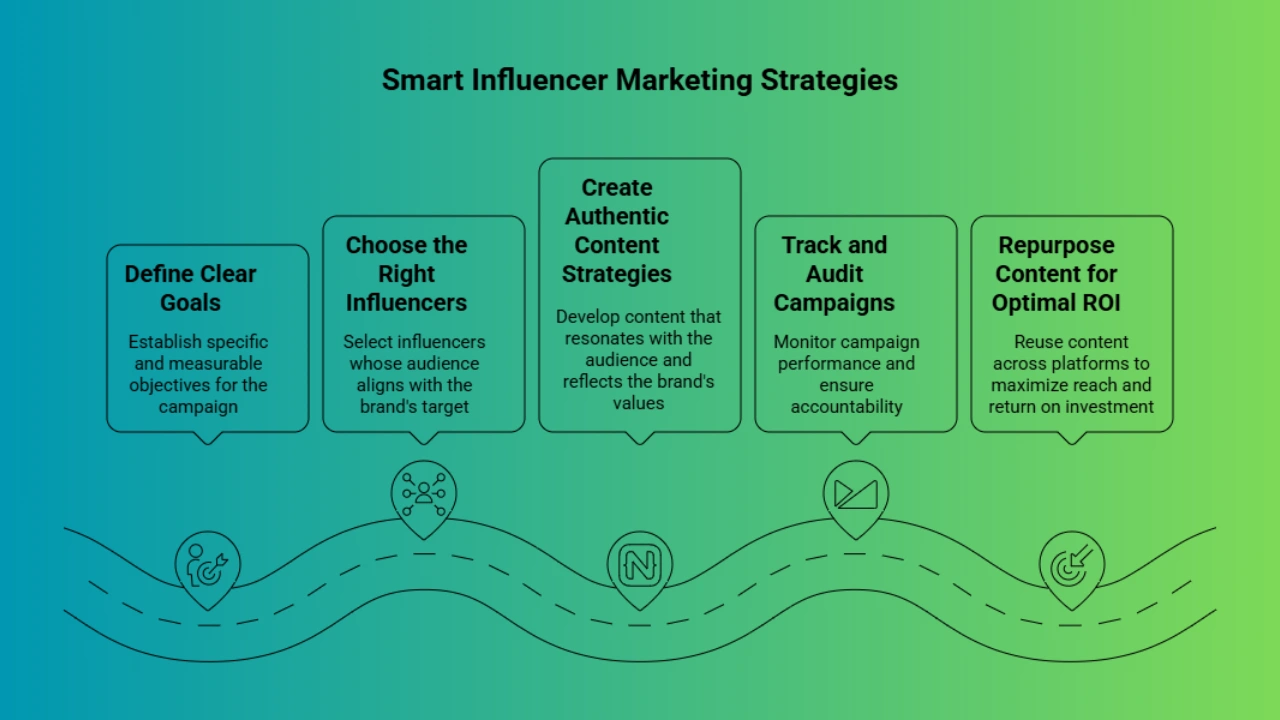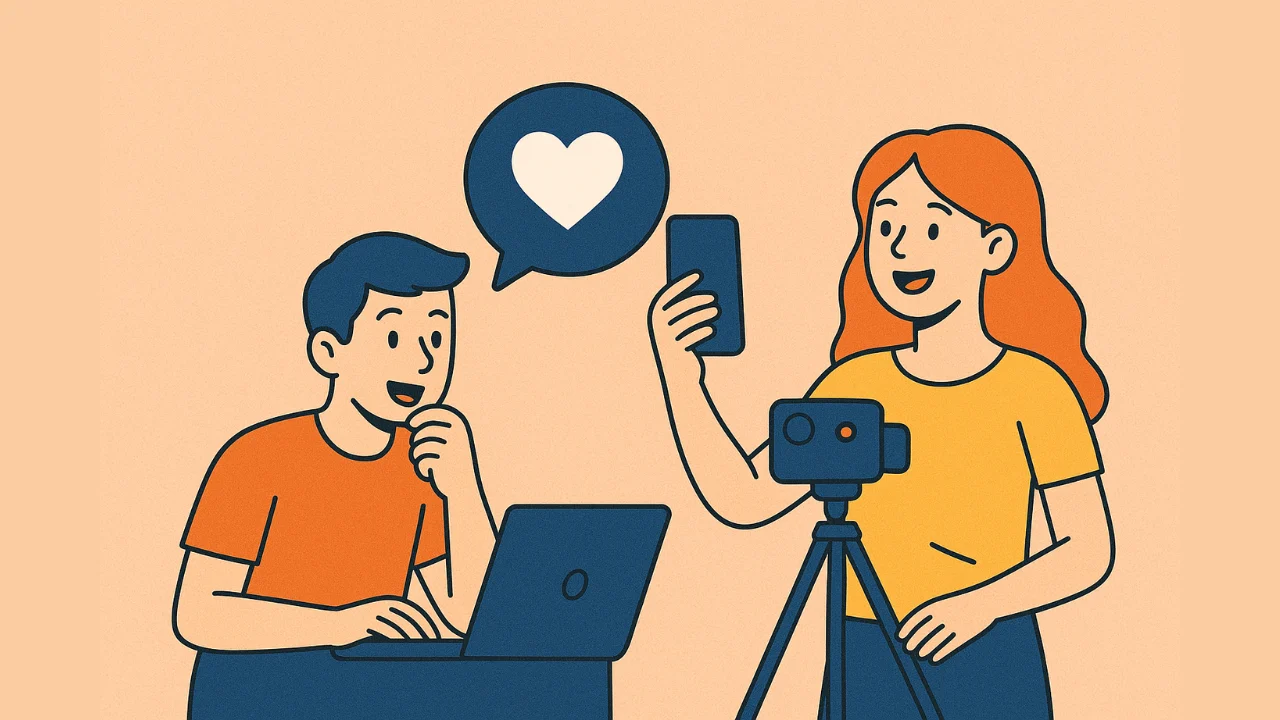Highlights:
- Small is the New Big: The core of successful influencer marketing now lies with micro and nano-influencers, who offer authentic reach and trust.
- Video First: Prioritize short-form video content on platforms like TikTok and Instagram Reels for maximum engagement and brand storytelling.
- Leverage AI: Use AI tools for smart influencer discovery and to detect fraud, ensuring every dollar you spend is on genuine influence.
- Repurpose for ROI: Don’t let great content go to waste. Maximize your return by repurposing influencer videos and images across all your marketing channels.
- Transparency is Essential: In 2025, authenticity and clear disclosures are non-negotiable for building consumer trust and complying with new regulations.
What Influencer Marketing Means
Influencer marketing is one of the most effective ways of creating a real relationship between brands and people nowadays. It is done through collaboration with people who influence a given niche audience. They endorse products or services in a natural, relevant manner.
For startups and small businesses, influencer marketing is budget-friendly and effective. It builds trust, increases reach, and drives measurable results. However, as digital platforms grow more complex, influencer marketing brings challenges—like finding authentic influencers, avoiding fraud, and meeting stricter regulations.
This article breaks down what influencer marketing looks like in 2025, highlighting strategies, trends, and tools that startups and SMEs can use to thrive.
Major Influencer Marketing Trends in 2025
 1. Micro and Nano-Influencers Steer the Show
1. Micro and Nano-Influencers Steer the Show
The largest benefactors in 2025 are nano (1K–10K followers) and micro-influencers (10K–50K followers). They don’t necessarily have huge followings, but followers tend to be highly active.
- Nano-influencers’ engagement rates are 3%–8%, while mega-influencers’ rates are less than 2%. For a startup, this implies budget-friendly partnerships that establish credibility within a niche community.
2. Short-Form Video Dominates
Video is not just a must anymore—it’s social media royalty. TikTok, Instagram Reels, and YouTube Shorts rule influencer campaigns.
Content forms excelling in 2025 are:
- Short tutorials and reviews
- Behind-the-scenes narratives
- Live shopping experiences, where influencers test products live
Brands that use short-form video drive more conversions due to engaging, real-life storytelling.
3. AI Fuels Influencer Discovery and Insights
AI-driven platforms simplify the most challenging aspects of influencer marketing:
- Discovery: Heepsy and Upfluence are tools brands can use to discover influencers by niche, geography, and demographics.
- Fraud Detection: HypeAuditor eliminates bots and fake followers.
- Performance Tracking: AI streamlines campaign measurement, saving time and maximizing spend.
AI ensures startups achieve real reach without spending cash on fake influence.
4. Content Repurposing Maximizes Impact
Intelligent brands don’t make influencer content disappear after just one post. They repurpose it:
- Use influencer videos in paid ads
- Include influencer feedback in email marketing campaigns
- Insert influencer images on product pages
This doubles the ROI per campaign while preserving platform consistency.
5. Transparency and Ethics Mean More
Shoppers in 2025 are hyper-conscious of authenticity. Laws now mandatorily require strict disclosure of sponsored partnerships.
- Influencers should explicitly identify posts as #ad or #sponsored
- Brands must not create misleading endorsements
Authenticity is no longer a trend—it’s a prerequisite for consumer trust.
Smart Influencer Marketing Strategies for Startups & SMEs
 Step 1: Define Clear Goals
Step 1: Define Clear Goals
Begin by specifying what you wish to attain. Typical goals are:
- Create brand awareness
- Drive traffic to your website
- Generate leads or sales
Define measurable KPI such as engagement rate, conversions, or follower growth.
Step 2: Choose the Right Influencers
Don’t use follower numbers exclusively. Search for:
- Audience relevance
- Engagement rate (not reach)
- Authenticity of content
Make use of AI tools to verify authenticity before entering into any deal.
Step 3: Create Authentic Content Strategies
Collaborate with influencers to produce authentic, real-life content. Don’t use scripts. Get them to share personal experiences.
- Example: Rather than “selling,” ask influencers to document a day in their life with your product in a skincare routine.
Step 4: Track and Audit Campaigns
Continuously monitor KPIs and ensure compliance. A handy checklist:
- Are disclosures obvious (#ad, #sponsored)?
- Does content match brand messaging?
- What are the engagement and conversion rates each week?
Step 5: Repurpose Content for Optimal ROI
Get the most return on investment by repurposing influencer content:
- Share videos and images within paid social ads
- Include influencer reviews in the email
- Publish content on product pages and websites
This expands your investment without additional costs of production.
Case Study: How boAt Used Hyper-Local Influencer Marketing
boAt’s journey from a young, unknown startup to a market leader is a masterclass in modern marketing, largely fueled by its innovative and tiered influencer strategy. Rather than simply paying for endorsements, boAt built a relatable, aspirational brand identity by leveraging both celebrities and a vast network of micro-influencers.
Strategy:
To dominate the market, boAt adopted a tiered influencer strategy. While they used celebrities for broad brand awareness, their core growth driver was a vast network of micro-influencers to build a community and establish authenticity. The goal was to make their products a symbol of a modern, relatable lifestyle, not just a gadget.
Execution:
- Targeted Niches: boAt collaborated with micro-influencers across diverse, relevant niches—including gaming, fitness, music, and lifestyle. These creators integrated the products into their real-life content, such as a fitness vlogger using boAt earbuds during a workout or a gamer showcasing their headset during a live stream.
- Community Building: They fostered a sense of belonging by encouraging user-generated content (UGC) with the hashtag #IAmboAthead. This turned customers into brand advocates and created a constant stream of authentic, free advertising.
- Relatable Storytelling: The campaigns focused on emotion and everyday use cases rather than technical specs. This approach resonated deeply with a youth-centric audience who saw the products as an essential part of their identity.
Results:
- High Engagement: The micro-influencer content achieved engagement rates up to 3x higher than traditional ad campaigns.
- Cost-Effectiveness: By leveraging a wide network of smaller creators, boAt achieved a significantly lower cost per acquisition (CPA) compared to relying on expensive celebrity deals alone.
- Dominant Market Share: This strategy was a key factor in boAt’s rapid rise to become a market leader in India’s personal audio segment, successfully challenging established global brands.
Recommended Influencer Marketing Tools
- Heepsy: Low-cost influencer discovery, particularly micro/nano creators.
- Upfluence: End-to-end campaign management.
- HypeAuditor: Identifies fraud and authenticity analysis.
- Airtable/Trello: Manage influencer campaigns and calendars.
- Canva: Develop branded campaign assets.
Final Thoughts
In 2025, influencer marketing isn’t about celebrity names in large size—it’s about relatability, authenticity, and wise implementation. Startups and SMEs can be champions by targeting micro and nano-influencers, using AI, adopting short-form video, and content repurposing in order to squeeze out the most ROI.
The future of influencer marketing isn’t about spending more, but spending smart.

